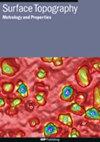Tribological behaviour of multi-shape photochemical textured surfaces
IF 2
3区 材料科学
Q2 ENGINEERING, MECHANICAL
引用次数: 0
Abstract
The purpose of this paper is to investigate the effect of multi-shape photochemical textured (PCT) steel surfaces on tribological performance. The textured surface with specific arrangement was fabricated by photochemical texturing, a common technique implemented in the microelectronic mechanical systems (MEMS) industry. It involves photolithography and chemical etching processes. The multi-shape studied were circle with line (CL) and circle with wavy (CW). Fabricated samples’ surfaces were characterized by using a 3D optical profiler to check the produced texture’s dimension. The effect of six different etching times on the texture’s dimension was observed. Then, only two sizes of both multi-shape textures were considered for tribological characterization. It was conducted by using ball-on-disk tribo-tester under lubricated conditions. The results obtained are compared with the reference untextured (UT) surface. From the results, it is found that appropriate size and shape of texture could lead to good friction reduction and anti-wear behaviour. The smaller size, size A, of CL multi-shape presented a lower friction coefficient compared to size B. However, different size of CW multi-shape has no effect on the friction behaviour. This is believed due to higher area density of CW compared to CL resulting in detrimental effect on friction for both CW’s size. Additionally, CL(size A) textured surface shows improved tribological behaviour compared to UT surface as lower friction coefficient and better wear resistance is obtained. This is maybe due to effective lubricating layer formation, good debris trapping effect and lower contact stress of the CL(size A) textured surface. These beneficial effects were achieved under lubricating condition through an increase in applied load.多形状光化学织构表面的摩擦学行为
本文的目的是研究多形状光化学织构(PCT)钢表面对摩擦学性能的影响。利用微电子机械系统(MEMS)中常用的光化学织构技术,制备了具有特定排列的织构表面。它涉及光刻和化学蚀刻工艺。所研究的多形态有圆带线(CL)和圆带波(CW)。利用三维光学轮廓仪对制备样品的表面进行表征,以检查所产生的纹理尺寸。观察了6种不同刻蚀时间对织构尺寸的影响。然后,只考虑两种多形状纹理的两种尺寸进行摩擦学表征。在润滑条件下,利用球盘摩擦试验机进行了试验。所得结果与参考的未纹理(UT)表面进行了比较。结果表明,适当的织构尺寸和形状可以获得良好的减摩和抗磨性能。尺寸较小的连续波多形A的摩擦系数低于尺寸b,而不同尺寸的连续波多形对摩擦行为没有影响。这被认为是由于连续油管的面积密度比连续油管高,这对两种连续油管的摩擦力都有不利影响。此外,与UT表面相比,CL(尺寸A)织构表面具有更好的摩擦学性能,摩擦系数更低,耐磨性更好。这可能是由于有效的润滑层形成,良好的碎屑捕获效果和CL(尺寸A)织构表面较低的接触应力。这些有益的效果是在润滑条件下通过增加施加的载荷来实现的。
本文章由计算机程序翻译,如有差异,请以英文原文为准。
求助全文
约1分钟内获得全文
求助全文
来源期刊

Surface Topography: Metrology and Properties
Materials Science-Materials Chemistry
CiteScore
4.10
自引率
22.20%
发文量
183
期刊介绍:
An international forum for academics, industrialists and engineers to publish the latest research in surface topography measurement and characterisation, instrumentation development and the properties of surfaces.
 求助内容:
求助内容: 应助结果提醒方式:
应助结果提醒方式:


